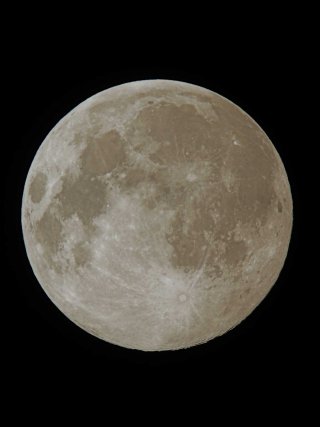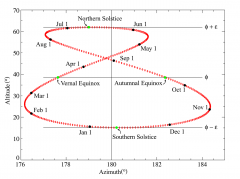The first of this month’s two full moons is scheduled for today at 2:32 a.m. EST. Below is a picture of last night’s moon, just a few hours away from full.
If you wanted to see it for yourself, where in the sky should you look to find the full moon? Well, obviously you’d just look up and hope there were no clouds blocking your view. But what if there were, and you still wanted to know where the moon was? Or say you were planning a very complicated photo shoot, with lots of setup, and need to know where the moon will be before you schlep everything to the wrong location? Well, that’s quite a story. And not one I have the answer to. But I can help you at least understand the basic pattern of where the moon will be throughout the year.
Turns out that the first quarter moon and the sun start off at roughly the same spot in the sky every March equinox. (Roughly, not exactly: if it were the exact same spot in the sky, we’d have a solar eclipse, wouldn’t we? Also, the moon’s phase isn’t always exactly aligned with the calendar day; whatever first quarter moon is closest to the equinox is the one that we have to use.)
That is, whatever elevation the sun has in your neighborhood on that day, the elevation of the moon is just about the same. And it’s about midway between its northern and southern extremes, and midway between its highest altitude (distance above the horizon) and its lowest. But then things diverge rapidly.
The moon, silly little thing, rises and sets about an hour later every day. If you’ve ever seen an analemma, and understood what it represents, you can picture what happens to the moon in a m(o)onth: It drifts all the way north and all the way back south across our sky in a month, rather than a year:
At each successive lunation the first quarter moon loses about 1/12 in altitude (I say “about” 1/12th because if you know anything about the moon, you know that there are more than 12 moon months in a 12 month year). So in the first lunation after the March equinox, the first quarter moon is no longer as high as the moon can be, but is instead coming down off that high point. The next time any phase of the moon reaches the extreme altitude is the June solstice, when the new moon is as high as the moon gets (but of course, one can’t see the new moon, so…).
But whereas the Sun attains its highest elevation only once in a year (at the June solstice), the moon attains it four times a year: first quarter moon in March, new moon in June, third quarter moon in September, and Full moon in December. Are you with me? I’m not, and I just learned all this stuff. There’s a good, but complicated, explanation in Antonin Rukl’s Atlas of the Moon. How’s about a graphic? Well, as it turns out, after an exhaustive search of the internot, I have been unable to find one. But I did find a site that shows the elevation of the next 14 full moons that’s kind of nice…
So at any event, this full moon, and the next one (scheduled for December 31st), are really high up there.
Now, because there are two moons in this calendar month, some people say that the second full moon, on December 31, should be called a blue moon. They’re right, but not in the historical Maine Farmer’s Almanac sense of the blue moon. I’ll tell you more about that when the time comes, but suffice to say that it doesn’t make any sense at all to call this full moon the Christmas Moon, when there will be another full moon only six days after Christmas…




I saw the moonrise last night on my way to get dinner. It was very clear and I regretted not being able to take a photo (cell would never be acceptable). It is unlikely I’ll have another chance tonight as we have more snow.
Some day I’d like to do long term time lapses of the moon. I did daytime lapses of a nice mountain view for 3+ years, but never had a camera decent enough to do anything with the moon so I stopped capturing every night at sunset.
I have a blog to write some day about a very strange effect of pine trees lifting up branches for no discernible reason such as getting more sunlight. I suspect it was an air pressure or temperature effect with some simple chemical or physical explanation, though I can’t rule out behavioral response either.
@oroboros:
The pine trees lifting their branches sounds like there should be a temperature and phloem distribution answer. No need for photosynthesis at night, so there’s less weight of fluid in/on the branches?
I’ve always wanted to do time lapse photography of anything, but I don’t really have a good view of anywhere that I’d be willing to leave either a camera or marks for aligning a tripod if I did have to tear down every time. I need to move, I guess. The house is getting crowded, and I want more space!
Hi Ben, Here in the Pacific Time Zone our newspaper said that our full moon was at 11:32 pm on the 1st of December, the only time zone where it occurred on the first and not the 2nd. Have you an explanation for how they determine the exact time of these events (whther by observation, and if so how, or, as I would guess is more likely, by calculation)? Pop
@pop: The full moons are always calculated well in advance. The people who write lunar calculation apps (for example, time and date dot com) refer to the calculations of one Ernest W. Brown, who did some number crunching back in the 1920s; there’s also the work of Jean Meeus, who appears to have calculated everything in the observable universe at one point or another. I don’t have the math to follow it, of course, but there must have been one particular full moon that everyone decided was “the” full moon to get started from. And I don’t know the story. I’m sure it’s an interesting one, and I need to do some reading to find out more.